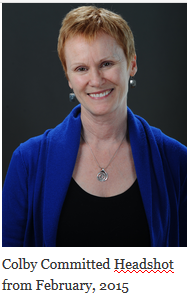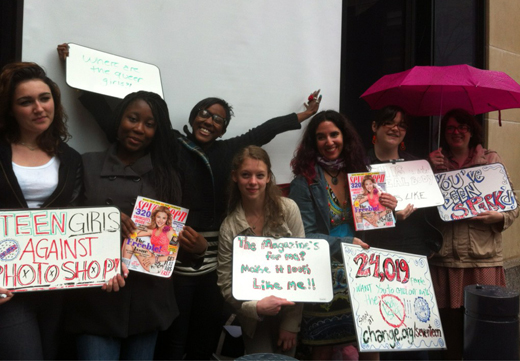 Sept. 14, 2016 Warning! This book may fly in the face of how you’re working with young people, and jolt you into an awareness from which you may never see yourself or your work in the same way again.
Sept. 14, 2016 Warning! This book may fly in the face of how you’re working with young people, and jolt you into an awareness from which you may never see yourself or your work in the same way again.
Part “how-to” guide for intergenerational relationships, and part media literacy peeking behind the stagecrafting of today’s journalism narratives, the case studies have universal application far beyond the title, Powered by Girl as good mental floss for ANYone working alongside youth, not just in the girl sphere.
In book stores today, it’s written by veteran media literacy truth-teller, tenacious culture-jammer and long time-ally of our mission Lyn Mikel Brown. Her standards for “keeping it real” with youth are light years from what I’ve seen masquerading as mentoring in so many spheres, with critical consciousness and authenticity at the forefront of her work. (See some of our earliest posts about her prior books co-authored with EdD Sharon Lamb: Packaging Girlhood and Packaging Boyhood)
Whether you’re navigating a multi-generational workplace, recruiting interns, or mindful about chasms of respect and cultural credos among generations that can get in the way of doing good work, you can glean some ‘aha’ moments and save a ton of spinning on the backend of “what happened to that team, why didn’t that project work” by digging deep into relationship building of trust and value at the onset.
I had a few squirm-worthy moments myself, recognizing the role of “adults trying too hard,” and it made me roll my eyes in wistful “where was this book ten years ago” thinking back to when I first started Shaping Youth. I tossed out the ‘mini-me’ models of collaboration early on, but her insightful candor unpacking the default “lean in” style of leadership, which often aims at trying to get a seat at the table, with her version of “activism” which shapes the public sphere itself could’ve shortcut my effort to re-imagine the process differently…
“Opening ourselves to genuine relationship is about seeing who they are and not who we think they should be. Addressing this barrier between what is and what we think or want is our work, not theirs.” –Lyn Mikel Brown
Good stuff. This is particularly palpable when I see corporate poseurs eager to ‘include youth’ on panels without truly giving voice to them, or inviting ‘teen experts’ as cursory tokenism in a sound bite style of “hearing what youth have to say.”
The type of engagement she speaks of is raw, real, commitment to personal growth and mutual learning from all parties…It’s the kind of change-making that impacts organizations at a profound, visceral level.
The content and case studies may be “Powered by Girl,” but the deeper message of respect, inclusion, diversity of thought and unbridled action offer wisdom in work that we all could use wrapping our heads around. Youth are seldom given the reins with all the inherent risks and rewards that come with it, and though the work style is a tough slog to establish in full, educators, youth organizations, community boards and employers should at least put it on their reading list for a shoulder shake to enhance their own skills toward greater understanding.
On loud, rowdy, crazy boisterousness amidst painful, challenging discussions:
”It occurred to me that some of the most insightful moments came out of the joking around…sometimes that is where a key gem of information comes out; {they’re} trying to bring attention to something that they couldn’t bring up in a serious way.”
On genuine engagement and listening to youth:
“Check your PhD a the door, your job title…even your ‘50 years experience working with girls’ mean nothing here…no academic or policy-based jargon…meet us where we are. ..Don’t momsplain. Don’t put words into our mouths…I’m not your daughter…” –16y.o giving advice to a U.N. working group on girls
Stage-Crafting Girlpower…What Sells
In the first twenty pages, we’re whisked behind the curtain of Oz privy to countless media moments where youth have wound up center stage how journalist hype and “shero” narratives distort the lens into the “The Myth of the Special Girl” often positioning a storyline of a do-it-yourself, lone, ambitious, over-achiever, despite the fact that it’s not a remotely accurate reflection of how real work gets done.
“The Tedification of thought and discourse,” descriptor of what current youth leadership looks like had me applauding with a fist-pumping, “yes, yes, I see this all the time” grooming of youth into robo-style “personal brands” to be inserted into adult-coached platforms, all too often treating teens as props in an elaborate if formulaic approach to ‘giving voice’ to issues of concern.
 From the Easy Bake Oven petition of 13 year old McKenna Pope to the highly successful Nike Girl Effect campaign, Lyn Mikel Brown helps connect the dots to the commodification of storytelling, complete with societal cheerleading of “can-do” gusto and “magical thinking” narratives that media loves to trot out in lieu of the hard reality of layers upon layers of intergenerational support so vital to making social change productive, proactive and sustainable.
From the Easy Bake Oven petition of 13 year old McKenna Pope to the highly successful Nike Girl Effect campaign, Lyn Mikel Brown helps connect the dots to the commodification of storytelling, complete with societal cheerleading of “can-do” gusto and “magical thinking” narratives that media loves to trot out in lieu of the hard reality of layers upon layers of intergenerational support so vital to making social change productive, proactive and sustainable.
Granted, as the founder of several ‘girl powered’ organizations she’s founded (Spark Movement, Hardy Girls, PBG) Lyn Mikel Brown has had a hands-on, in-the-trenches snapshot of this “picture perfect” photo album of mediated moments, seeing how complex teams of partners, allies, and youth collaborations vanish in favor of promoting solo sojourns that achieve high visibility in a blink.
She reminds, “Young activists don’t just pop up fully formed and informed. They are brave, passionate and wide awake, yes, but they don’t possess unique activist genes.” They benefit from supportive environments scaffolded by those with deep skills sharing knowledge and resources; parents and privilege further contextualize the hearty success of pre-pubescent “kidpreneurs” taking the stage so often as wunderkind.
And what happens if one tries to reframe the narrative to properly insert the adult community that’s supporting this reality? Often the youth get painted as a ‘shill’ or a ‘sock puppet’ of an adult agenda, as Lyn explains:
“This is a zero sum game. She can’t win for losing, either she does something remarkable all on her own, which ignores social reality, or she is a pawn, easily used or manipulated and worthy of dismissal.”
 Then there’s the subtext of the reality behind the reality…in “that was then, this is now” retrospective.
Then there’s the subtext of the reality behind the reality…in “that was then, this is now” retrospective.
Remember when then 14 year old Julia Bluhm served up a “SPARK” to Seventeen magazine igniting a bonfire of change by asking to curb Photoshop for just one spread?
Back then I wrote about Julia Bluhm’s backstory of support by the SPARK team and dissected the media machinations of what it takes to amplify youth voices like this effectively, but as Julia Bluhm herself reminded in the book, media pundits repeatedly reframed it, altered or omitted key truths, then repackaged and served it with a different dressing and a side of atta girl.
“They probably thought the headline starting “One Teenage Girl from Maine…” would make more money than the headline starting “A Group of 20 Activist Teens…” so they changed it.” –Julia Bluhm
Lyn said, “Julia understood both the market value of her story and the heavy costs to girls everywhere of reducing her complex set of experiences to “special girl” status. Telling a “you start a petition, you can change the world” story of individual effort erased the very conditions necessary for the action’s success and vital to the education of other girls who might want to become activists like her.”
 This was also one of many efforts of the SPARK movement which started as an ember, looked like it might fizzle until an all-out collective effort helped fan the flame to spread wildly, picking up partnerships and exposure along the way. But that just doesn’t play as well in the press…especially since Seventeen initially rejected the protest and then milked it full tilt to differentiate themselves from Teen Vogue which hadn’t ever aboard.
This was also one of many efforts of the SPARK movement which started as an ember, looked like it might fizzle until an all-out collective effort helped fan the flame to spread wildly, picking up partnerships and exposure along the way. But that just doesn’t play as well in the press…especially since Seventeen initially rejected the protest and then milked it full tilt to differentiate themselves from Teen Vogue which hadn’t ever aboard.
“The girl activists whose stories make the nightly news are the ones easily re-imagined into salable commodities. Arranging these for mass consumption is not unlike staging a home for sale…One attracts the greatest pool of prospective buyers to a property by getting rid of the clutter, removing signs of relationships, family stories, cultural backgrounds, lived experience, anything that might prevent people from seeing themselves in the space.” –Lyn Mikel Brown
In anecdotal “where are they now” media fashion, fast forward from Spark’s 86,000 signature Seventeen petition of 2012 spearheaded by Julia Bluhm and Izzy Labbe now entering college, reflecting on their stint as agents of change with savvy skill sets and intergenerational communication cred they’ll bring to any project here on out.
In part two we’ll talk more about what happens as adults become witnesses and advocates for youth perspectives, and relationships transform never to be the same again…
At its best, intergenerational work should not be transactional, it should be transformative.
Thankfully, that’s the ONLY way some of us now know how to work these days.
I think I’ll leave it right there for now, picking up more in a part two and in conversation with the author, where I’ll also share my copy of Powered by Girl in keeping with our “pass through policy” of sharing any books received, and end on this representative quote that captures the tonality of the book well…
“You are the expert on your own experiences.”–Spark’s E.D. Dana Edell
When people contact her asking to come talk about teenage girls, her response speaks volumes:
“Actually, I have teenage girls who can talk about teenage girls.”








This looks a very insightful book for dealing with the youths and shaping them into better and responsible adults. I’m gonna read it.